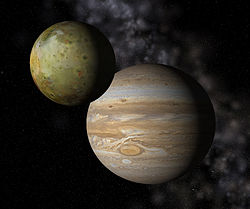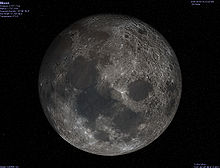Celestia
| Celestia
|
|
|---|---|

|
|
 View of the planet Jupiter and its moon Io |
|
| Basic data
|
|
| developer | Celestia developer group |
| Current version | 1.6.1 (June 10, 2011) |
| operating system | Linux , FreeBSD , macOS , Windows |
| programming language | Lua , C ++ |
| category | Astronomy program |
| License | GPL ( Free Software ) |
| celestia.space | |
Celestia is a 3D - astronomy program for Windows , macOS , FreeBSD and Linux , developed by Chris Laurel. It is open source and GPL licensed. Since October 20, 2008 there is also a portable version of PortableApps . As for the standard version, there is a German language pack for the portable version on the German Celestia website.
The program allows users to simulate objects on the scale of the International Space Station to galaxies like the Milky Way in three dimensions. The program uses OpenGL as a 3D library . Unlike normal planetarium software, the user is able to move freely through the universe . In this and other properties it is similar to the Space Engine program .
The NASA and ESA have recognized the potential of Celestia and used it for their own demonstration purposes (see below links) . Not to be confused with Celestia is ESA's own Celestia 2000 program . The ESA now uses Celestia in an independent program (Space Trajectory Analysis) for the analysis, simulation and visualization of flight paths.
The Institute for Space Systems at the University of Stuttgart uses Celestia as a live visualization for the system simulation infrastructure set up in cooperation with EADS Astrium as part of the satellite development. The OpenSimKit system simulation infrastructure used for teaching at the institute also represents the simulated upper stage rocket with Celestia.
From version 1.3.1, Celestia is also offered in a German language version.
At the beginning of August 2016, the care and maintenance of Celestia was taken over by a Russian Celestia enthusiast and the user forum was reactivated.
Functions
- "Travel Guide" (collection of some important places in the solar system )
- Solar and lunar eclipse calculator for all planets up to the year 9999.
- The basic program includes the Hipparcos catalog (120,000 stars).
- It is possible to take screenshots and record the moving events on the screen as a video.
- The time can be set arbitrarily far into the future or past.
- Constellations and orbits of planets, moons , asteroids , comets and satellites can be displayed.
- The names of all objects in space can be displayed: galaxies, star clusters , stars , planets, moons, asteroids, comets, satellites.
- The names of cities, impact craters , observatories , valleys, landing points, continents, mountains and lakes can be displayed.
- The radius, distance, day length and average temperature of the planets are displayed.
- Stars show the distance, the luminosity in comparison to the sun, the class, surface temperature, the radius and the rotation time.
- The number of stars visible can be varied.
- The field of vision can be varied continuously.
- The apparent brightness of the stars can be adjusted in three stages
- The image can be split so that several objects can be observed at the same time.
- The speed of light can be ignored or taken into account.
- Gamepad support
restrictions
- The default setting for the earth is a perfect sphere. In order to be able to represent the earth correctly, this must be set in a program file.
- All galaxies and stars are stationary (with the exception of binary star systems where the center is fixed). Even with very strong time acceleration it is therefore not possible to observe a rotation of the galaxy.
- Some binary star systems are not yet displayed correctly.
Extensions
Over 10 GB of extensions (so-called add-ons) are available to supplement the basic program. This enormous amount is the result of the activities of a small but very productive user community that supports the program. The largest collection is provided by the portal "The Celestia Motherlode" (see web links). These "add-ons" include the following areas:
The textures of the planets and other celestial bodies, such as moons and comets, can be exchanged for very high-resolution textures (up to 128,000 × 64,000 pixels), normal maps or bump maps , specular maps (for reflections), cloud textures and night textures. For the earth, for example, satellite images are also made available, which are integrated via so-called "virtual textures", which enables a very detailed view of the planets. 3D objects for particularly high mountains or famous buildings can be built in to get an even more realistic view. Political maps or scientific textures, such as the gravitational distribution on the planet's surface, are also available and can be quickly selected in the program.
There are different databases, from objects the size of satellites to moons, asteroids and stars to galaxies. The expanded star database alone has two million stars and the galaxy database almost 2,000, which also makes galaxy clusters visible. The earth's city database can be expanded to 96,000 locations.
It is possible to incorporate trajectories from satellites. In this way, the complete missions (for example Cassini-Huygens ) can be simulated.
The user community has developed scripts that guide the user through the solar system, similar to the planetarium. Special documentations in text format, called Educational Activities , which provide information about the birth and death of the stars, for example, are linked to Celestia, so that such topics can be clearly explained.
Extensions for science fiction enthusiasts have also been developed that simulate universes from famous films such as Star Wars or Star Trek , but also planetary systems they have thought up themselves without reference to a film or a book.
As of version 1.5.1, Celestia also supports the execution of add-ons that are written in the Lua scripting language . A C library contained in Celestia accesses the Lua interpreter for this purpose.
literature
- Dickmann, Ulrich (2007): The great Celestia manual . (400 pages). bomots. ISBN 978-3-939316-32-9
Web links
- Official website of the project
- Official German-language website for Celestia (including German-language Win32 program version)
- The Celestia Motherlode - Collection of add-ons from various authors
- Celestia Wiki Book (English)
- This website also has a wiki book devoted entirely to Celestia. (English France)


